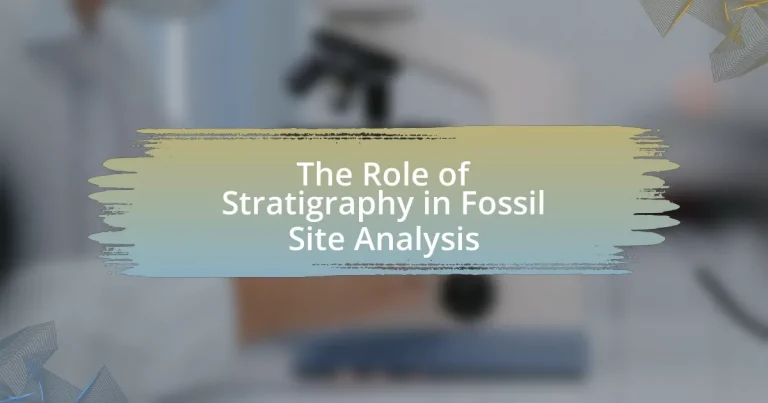Stratigraphy is a critical discipline in fossil site analysis, providing a framework for understanding the temporal and spatial distribution of fossils within sedimentary layers. It enables paleontologists to accurately date fossils and reconstruct past environments through principles such as the Law of Superposition and biostratigraphy. The article explores how stratigraphic layering affects fossil preservation, the methods used for dating fossils, and the challenges faced in stratigraphic analysis. Additionally, it discusses the interaction of stratigraphy with other scientific disciplines, the practical applications in fossil research, and the modern technologies that enhance stratigraphic mapping and analysis.

What is the Role of Stratigraphy in Fossil Site Analysis?
Stratigraphy plays a crucial role in fossil site analysis by providing a framework for understanding the temporal and spatial distribution of fossils within sedimentary layers. This discipline allows paleontologists to date fossils accurately and reconstruct past environments by examining the sequence and characteristics of rock layers. For instance, the Law of Superposition states that in undisturbed strata, older layers are found beneath younger ones, enabling researchers to establish a chronological order of fossil deposition. Additionally, biostratigraphy, which utilizes fossil content to correlate and date strata, further enhances the understanding of evolutionary timelines and ecological changes. Thus, stratigraphy is essential for interpreting the geological history and paleobiology of fossil sites.
How does stratigraphy contribute to understanding fossil sites?
Stratigraphy contributes to understanding fossil sites by providing a framework for dating and contextualizing the layers of sedimentary rock where fossils are found. This discipline allows scientists to analyze the sequence of rock layers, known as strata, which can reveal the relative ages of fossils and the environmental conditions at the time of deposition. For instance, the Law of Superposition states that in undisturbed strata, older layers are found beneath younger layers, enabling researchers to establish a chronological order of fossilized organisms. Additionally, biostratigraphy, which uses fossil assemblages to correlate and date rock layers, further enhances the understanding of evolutionary timelines and paleoecological contexts. This method has been validated through numerous geological studies, such as those conducted in the Burgess Shale, where stratigraphic analysis has elucidated the Cambrian explosion of life.
What are the key principles of stratigraphy relevant to fossil analysis?
The key principles of stratigraphy relevant to fossil analysis include the Law of Superposition, the Principle of Original Horizontality, and the Principle of Lateral Continuity. The Law of Superposition states that in undisturbed sedimentary layers, the oldest layers are at the bottom and the youngest are at the top, which helps in determining the relative ages of fossils found within those layers. The Principle of Original Horizontality posits that layers of sediment are originally deposited horizontally, allowing geologists to identify any subsequent tilting or folding that may have occurred, which can affect fossil distribution. The Principle of Lateral Continuity suggests that layers of sediment initially extend laterally in all directions; this principle aids in correlating fossil finds across different locations. These principles are foundational in reconstructing the geological history and understanding the context of fossil assemblages.
How does stratigraphic layering affect fossil preservation?
Stratigraphic layering significantly affects fossil preservation by providing a protective environment that can enhance the likelihood of fossilization. The layers of sediment that accumulate over time can bury organic remains quickly, reducing exposure to elements that cause decay, such as oxygen and scavengers. For instance, in the case of the La Brea Tar Pits, the asphalt layers preserved numerous fossils by encasing them and preventing decomposition. Additionally, the mineral composition of the layers can influence the chemical processes involved in fossilization, with certain sediments promoting the replacement of organic material with minerals, thus enhancing preservation.
Why is stratigraphy important for dating fossils?
Stratigraphy is important for dating fossils because it provides a framework for understanding the chronological sequence of rock layers and their associated fossils. By analyzing the stratigraphic context, paleontologists can determine the relative ages of fossils based on their position within these layers. For instance, the Law of Superposition states that in undisturbed sedimentary rock layers, older layers are found beneath younger layers, allowing scientists to infer the age of fossils based on their depth. This method has been validated through numerous geological studies, such as those conducted in the Grand Canyon, where distinct fossil assemblages correspond to specific geological periods, thereby reinforcing the reliability of stratigraphic dating.
What methods are used in stratigraphy for dating fossils?
Stratigraphy employs several methods for dating fossils, primarily including relative dating and absolute dating techniques. Relative dating involves analyzing the stratigraphic layers in which fossils are found, allowing scientists to determine the chronological order of events based on the principle of superposition, where lower layers are older than those above them. Absolute dating, on the other hand, utilizes radiometric techniques, such as carbon-14 dating for organic materials and uranium-lead dating for older rocks, providing a specific age estimate for fossils. These methods are validated by their consistent application in geological studies, where stratigraphic correlations and radiometric dating have been used to construct detailed geological timelines.
How do stratigraphic correlations enhance fossil dating accuracy?
Stratigraphic correlations enhance fossil dating accuracy by allowing scientists to compare rock layers across different geographic locations, establishing a timeline of geological events. This method relies on the principle of superposition, where younger layers are deposited on top of older ones, and the identification of index fossils, which are species that existed for a relatively short geological time. By correlating these layers and fossils, researchers can more precisely date the age of fossils found in different locations, as demonstrated by the use of the Cambrian explosion fossils, which provide a clear temporal framework for dating subsequent fossil finds. This correlation process increases the reliability of dating methods, as it integrates data from multiple sites, leading to a more comprehensive understanding of the fossil record.
What challenges are faced in stratigraphic analysis of fossil sites?
Stratigraphic analysis of fossil sites faces several challenges, including the complexity of geological formations, the potential for post-depositional alterations, and the difficulty in correlating stratigraphic layers across different locations. Geological formations can vary significantly in composition and structure, making it challenging to interpret the depositional environment accurately. Post-depositional alterations, such as erosion, tectonic activity, or bioturbation, can disrupt the original stratigraphic context of fossils, complicating their dating and ecological interpretation. Additionally, correlating stratigraphic layers across different sites requires extensive fieldwork and can be hindered by gaps in the geological record, leading to uncertainties in reconstructing past environments and evolutionary timelines.
How do geological disturbances impact stratigraphic records?
Geological disturbances significantly alter stratigraphic records by causing disruptions in sediment deposition and layering. These disturbances, such as earthquakes, volcanic eruptions, and landslides, can lead to the mixing of sediment layers, erosion of existing strata, and the introduction of new materials, which complicates the chronological interpretation of geological history. For instance, the 1980 eruption of Mount St. Helens resulted in the rapid deposition of volcanic ash that buried existing layers, creating a new stratigraphic record that obscured previous geological formations. This evidence illustrates how geological events can fundamentally change the stratigraphic context, making it challenging for researchers to accurately reconstruct past environments and biological evolution.
What are the limitations of stratigraphy in fossil site analysis?
Stratigraphy has several limitations in fossil site analysis, primarily due to its reliance on sedimentary layers that may not always accurately represent the chronological sequence of events. One significant limitation is the potential for bioturbation, where organisms disturb sediment layers, leading to mixed or displaced fossils that complicate the interpretation of their age and context. Additionally, stratigraphic correlation can be challenging when layers are not continuous or are subject to erosion, resulting in gaps in the geological record. Furthermore, the fossilization process itself can be selective, with certain organisms more likely to be preserved than others, leading to a biased representation of past biodiversity. These factors collectively hinder the ability to construct a precise and comprehensive understanding of the temporal and environmental context of fossil sites.

How does Stratigraphy Interact with Other Disciplines in Fossil Analysis?
Stratigraphy interacts with other disciplines in fossil analysis by providing a framework for understanding the temporal and spatial distribution of fossils within sedimentary layers. This interaction is crucial for paleontology, geology, and archaeology, as stratigraphy helps to date fossils and correlate them with geological events. For instance, biostratigraphy utilizes fossil content to establish relative ages of rock layers, while lithostratigraphy focuses on the physical characteristics of the strata. Additionally, stratigraphy informs paleoecology by revealing past environments through sediment analysis, which aids in reconstructing ancient ecosystems. The integration of stratigraphic data with radiometric dating techniques further enhances the accuracy of fossil age determinations, thereby solidifying the relationship between stratigraphy and other scientific fields in fossil analysis.
What role does stratigraphy play in paleontology?
Stratigraphy plays a crucial role in paleontology by providing a framework for understanding the temporal and spatial distribution of fossils within sedimentary rock layers. This discipline allows paleontologists to date fossils accurately and reconstruct past environments by analyzing the sequence and characteristics of rock strata. For instance, the Law of Superposition states that in undisturbed layers, older strata lie beneath younger ones, enabling scientists to establish relative ages of fossils found within those layers. Additionally, biostratigraphy, which uses fossil assemblages to correlate and date rock layers, further enhances the understanding of evolutionary timelines and ecological changes.
How does stratigraphy inform the ecological context of fossils?
Stratigraphy informs the ecological context of fossils by providing a chronological framework that reveals the environmental conditions at the time of deposition. This framework allows scientists to correlate fossil assemblages with specific geological layers, indicating the habitat and climate in which the organisms lived. For instance, the presence of certain sediment types, such as coal deposits, suggests a lush, swampy environment, while sandstone layers may indicate a drier, more arid setting. Additionally, stratigraphic analysis can uncover patterns of biodiversity and extinction events, helping to understand how ecological factors influenced the evolution and distribution of species over time.
What interdisciplinary approaches enhance stratigraphic analysis?
Interdisciplinary approaches that enhance stratigraphic analysis include integrating geology, paleontology, geochemistry, and remote sensing. Geology provides the foundational understanding of rock layers and their formation processes, while paleontology contributes insights into the biological context of fossil assemblages within those layers. Geochemistry aids in analyzing the chemical composition of sediments, which can reveal environmental conditions at the time of deposition. Remote sensing technologies, such as LiDAR and satellite imagery, allow for the mapping of geological features and stratigraphic relationships over large areas, facilitating a more comprehensive analysis of fossil sites. These combined methodologies lead to a more robust interpretation of stratigraphic data, improving the accuracy of geological and paleontological reconstructions.
How does stratigraphy relate to sedimentology in fossil studies?
Stratigraphy is the study of rock layers and layering, while sedimentology focuses on the processes of sediment formation and deposition. In fossil studies, stratigraphy provides a framework for understanding the temporal and spatial context of sedimentary deposits, which is crucial for interpreting the environmental conditions in which fossils were formed. For instance, the identification of specific sedimentary structures and facies within stratigraphic layers can reveal information about past ecosystems and the conditions under which organisms lived. This relationship is evidenced by the use of stratigraphic columns in paleontological research, which help correlate fossil assemblages with specific geological time periods and depositional environments, thereby enhancing the understanding of evolutionary processes and biodiversity changes over time.
What sedimentary processes are crucial for fossil preservation?
Sedimentary processes crucial for fossil preservation include rapid burial, anoxic conditions, and sediment compaction. Rapid burial protects organic remains from decay and scavenging, while anoxic conditions inhibit the activity of decomposers, allowing for better preservation of soft tissues. Sediment compaction further aids preservation by reducing pore space and limiting the movement of fluids that could lead to decomposition. These processes are evidenced by fossil-rich sedimentary rock formations, such as the Burgess Shale, where exceptional preservation of soft-bodied organisms occurred due to these specific conditions.
How can sedimentary structures indicate fossil site conditions?
Sedimentary structures can indicate fossil site conditions by revealing the depositional environment and energy levels present during sediment accumulation. For instance, features such as cross-bedding, ripple marks, and graded bedding provide insights into water flow, sediment transport, and the paleoenvironment. Cross-bedding suggests a high-energy environment like a river or dune, while ripple marks indicate shallow water conditions. These structures help paleontologists infer the ecological conditions that existed when the fossils were deposited, as certain organisms thrive in specific environments. Studies have shown that analyzing sedimentary structures can lead to a better understanding of fossil distribution and preservation, as evidenced by research published in the journal “Paleobiology,” which highlights the correlation between sedimentary features and fossil assemblages in various geological settings.

What are the Practical Applications of Stratigraphy in Fossil Site Analysis?
Stratigraphy has practical applications in fossil site analysis by providing a framework for understanding the temporal and spatial distribution of fossils within geological layers. This method allows paleontologists to date fossils accurately, as the principle of superposition indicates that lower layers are older than those above them. Additionally, stratigraphy aids in reconstructing past environments and ecosystems by analyzing sediment characteristics and fossil assemblages, which can reveal information about ancient climates and habitats. For instance, the study of stratified rock formations in the Badlands of South Dakota has led to significant discoveries about the Late Cretaceous period, demonstrating how stratigraphic analysis can yield insights into the evolutionary history of species.
How can stratigraphic analysis improve fossil excavation techniques?
Stratigraphic analysis can significantly improve fossil excavation techniques by providing a detailed understanding of the geological layers and their chronological sequence. This understanding allows paleontologists to identify the most promising strata for fossil recovery, thereby increasing the efficiency and success rate of excavations. For instance, stratigraphic context helps in predicting the location of fossils based on the sedimentary environment and the fossilization processes that occurred in specific layers. Studies have shown that excavations guided by stratigraphic data yield a higher density of fossils, as seen in the Hell Creek Formation, where targeted stratigraphic layers have produced numerous dinosaur fossils.
What best practices should be followed during stratigraphic excavation?
Best practices during stratigraphic excavation include meticulous documentation, careful stratigraphic layering, and systematic sampling. Meticulous documentation ensures that all findings are recorded accurately, including the context of each layer, which is crucial for understanding the geological history and fossil distribution. Careful stratigraphic layering involves excavating in horizontal layers to preserve the integrity of the stratigraphy, allowing for a clearer interpretation of the sequence of deposition. Systematic sampling entails collecting representative samples from each layer to analyze the sediment composition and fossil content, which aids in reconstructing past environments. These practices are supported by the principles of stratigraphy, which emphasize the importance of context in geological and paleontological studies.
How can stratigraphy guide the selection of fossil sites for research?
Stratigraphy can guide the selection of fossil sites for research by providing a framework for understanding the temporal and spatial distribution of sedimentary layers. This discipline allows researchers to identify specific geological formations that are likely to contain fossils based on their age and depositional environment. For instance, certain stratigraphic units, such as the Hell Creek Formation in North America, are well-documented for yielding dinosaur fossils, thus guiding paleontologists to target these areas for excavation. Additionally, stratigraphic analysis can reveal the paleoenvironmental conditions that influenced fossil preservation, further refining site selection.
What tools and technologies enhance stratigraphic analysis?
Geographic Information Systems (GIS), remote sensing, and 3D modeling software significantly enhance stratigraphic analysis. GIS allows for the integration and visualization of spatial data, facilitating the interpretation of geological formations and their relationships. Remote sensing technologies, such as LiDAR and satellite imagery, provide high-resolution data on surface features, enabling geologists to identify stratigraphic patterns over large areas. Additionally, 3D modeling software aids in the reconstruction of subsurface geology, allowing for a more comprehensive understanding of stratigraphic sequences. These tools collectively improve the accuracy and efficiency of stratigraphic analysis, as evidenced by their widespread use in geological surveys and research studies.
How do modern technologies improve stratigraphic mapping?
Modern technologies enhance stratigraphic mapping by utilizing advanced tools such as Geographic Information Systems (GIS), remote sensing, and 3D modeling. These technologies allow for precise data collection and analysis, enabling geologists to visualize subsurface structures and stratigraphic relationships more effectively. For instance, GIS integrates spatial data, facilitating the mapping of geological features and their distribution, while remote sensing provides aerial imagery that reveals surface characteristics indicative of underlying stratigraphy. Additionally, 3D modeling software enables the reconstruction of geological formations, improving the understanding of stratigraphic sequences and their temporal relationships. These advancements lead to more accurate interpretations of geological history and fossil site analysis, ultimately enhancing the effectiveness of stratigraphic studies.
What role do software and databases play in stratigraphic research?
Software and databases are essential in stratigraphic research as they facilitate the organization, analysis, and visualization of geological data. These tools enable researchers to manage large datasets, such as sedimentary layers and fossil records, allowing for efficient data retrieval and manipulation. For instance, Geographic Information Systems (GIS) software can integrate spatial data with stratigraphic information, enhancing the understanding of geological formations and their historical context. Additionally, databases like the Paleobiology Database provide access to extensive fossil records, supporting comparative studies and aiding in the identification of patterns in stratigraphic sequences. This integration of software and databases ultimately enhances the accuracy and efficiency of stratigraphic analysis, leading to more informed interpretations of geological history.
What are the best practices for integrating stratigraphy in fossil research?
The best practices for integrating stratigraphy in fossil research include thorough stratigraphic mapping, precise sedimentological analysis, and the application of biostratigraphy. Stratigraphic mapping allows researchers to document the spatial distribution of rock layers and fossil occurrences, which is essential for understanding the geological context of fossils. Sedimentological analysis provides insights into the depositional environments and processes that influenced fossil preservation, while biostratigraphy aids in correlating fossil assemblages with specific time intervals, enhancing the chronological framework of the research. These practices are validated by numerous studies that demonstrate the importance of stratigraphic context in interpreting paleoenvironments and evolutionary patterns.





